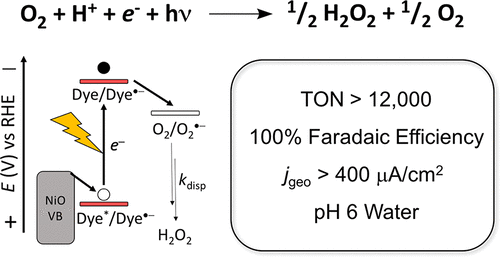当前位置:
X-MOL 学术
›
J. Am. Chem. Soc.
›
论文详情
Our official English website, www.x-mol.net, welcomes your
feedback! (Note: you will need to create a separate account there.)
Highly Active NiO Photocathodes for H2O2 Production Enabled via Outer Sphere Electron Transfer
Journal of the American Chemical Society ( IF 14.4 ) Pub Date : 2018-02-20 , DOI: 10.1021/jacs.8b00015 Onyu Jung 1 , Michael L. Pegis 1 , Zixuan Wang 1 , Gourab Banerjee 1 , Coleen T. Nemes 1 , William L. Hoffeditz 2 , Joseph T. Hupp 2 , Charles A. Schmuttenmaer 1 , Gary W. Brudvig 1 , James M. Mayer 1
Journal of the American Chemical Society ( IF 14.4 ) Pub Date : 2018-02-20 , DOI: 10.1021/jacs.8b00015 Onyu Jung 1 , Michael L. Pegis 1 , Zixuan Wang 1 , Gourab Banerjee 1 , Coleen T. Nemes 1 , William L. Hoffeditz 2 , Joseph T. Hupp 2 , Charles A. Schmuttenmaer 1 , Gary W. Brudvig 1 , James M. Mayer 1
Affiliation

|
Tandem dye-sensitized photoelectrosynthesis cells are promising architectures for the production of solar fuels and commodity chemicals. A key bottleneck in the development of these architectures is the low efficiency of the photocathodes, leading to small current densities. Herein, we report a new design principle for highly active photocathodes that relies on the outer-sphere reduction of a substrate from the dye, generating an unstable radical that proceeds to the desired product. We show that the direct reduction of dioxygen from dye-sensitized nickel oxide (NiO) leads to the production of H2O2. In the presence of oxygen and visible light, NiO photocathodes sensitized with commercially available porphyrin, coumarin, and ruthenium dyes exhibit large photocurrents (up to 400 μA/cm2) near the thermodynamic potential for O2/H2O2 in near-neutral water. Bulk photoelectrolysis of porphyrin-sensitized NiO over 24 h results in millimolar concentrations of H2O2 with essentially 100% faradaic efficiency. To our knowledge, these are among the most active NiO photocathodes reported for multiproton/multielectron transformations. The photoelectrosynthesis proceeds by initial formation of superoxide, which disproportionates to H2O2. This disproportionation-driven charge separation circumvents the inherent challenges in separating electron-hole pairs for photocathodes tethered to inner sphere electrocatalysts and enables new applications for photoelectrosynthesis cells.
中文翻译:

通过外球电子转移实现 H2O2 生产的高活性 NiO 光电阴极
串联染料敏化光电合成电池是生产太阳能燃料和商品化学品的有前途的架构。这些架构发展的一个关键瓶颈是光电阴极效率低,导致电流密度小。在此,我们报告了一种高活性光电阴极的新设计原理,该原理依赖于底物从染料的外球还原,产生不稳定的自由基,进而生成所需的产物。我们表明,染料敏化氧化镍 (NiO) 中分子氧的直接还原导致 H2O2 的产生。在氧气和可见光存在下,NiO 光电阴极被市售的卟啉、香豆素、和钌染料在接近中性水中的 O2/H2O2 的热力学势附近表现出大的光电流(高达 400 μA/cm2)。卟啉敏化 NiO 在 24 小时内的大量光电解产生毫摩尔浓度的 H2O2,法拉第效率基本上为 100%。据我们所知,这些是报告的用于多质子/多电子转换的最活跃的 NiO 光电阴极之一。光电合成通过超氧化物的初始形成进行,超氧化物歧化为 H2O2。这种歧化驱动的电荷分离避免了分离电子-空穴对的固有挑战,用于连接到内球电催化剂的光电阴极,并为光合作用电池提供了新的应用。卟啉敏化 NiO 在 24 小时内的大量光电解产生毫摩尔浓度的 H2O2,法拉第效率基本上为 100%。据我们所知,这些是报告的用于多质子/多电子转换的最活跃的 NiO 光电阴极之一。光电合成通过超氧化物的初始形成进行,超氧化物歧化为 H2O2。这种歧化驱动的电荷分离避免了分离电子-空穴对的固有挑战,用于连接到内球电催化剂的光电阴极,并为光合作用电池提供了新的应用。卟啉敏化 NiO 在 24 小时内的大量光电解产生毫摩尔浓度的 H2O2,法拉第效率基本上为 100%。据我们所知,这些是报告的用于多质子/多电子转换的最活跃的 NiO 光电阴极之一。光电合成通过超氧化物的初始形成进行,超氧化物歧化为 H2O2。这种歧化驱动的电荷分离避免了分离电子-空穴对的固有挑战,用于连接到内球电催化剂的光电阴极,并为光合作用电池提供了新的应用。与 H2O2 不成比例。这种歧化驱动的电荷分离避免了分离电子-空穴对的固有挑战,用于连接到内球电催化剂的光电阴极,并为光合作用电池提供了新的应用。与 H2O2 不成比例。这种歧化驱动的电荷分离避免了分离电子-空穴对的固有挑战,用于连接到内球电催化剂的光电阴极,并为光合作用电池提供了新的应用。
更新日期:2018-02-20
中文翻译:

通过外球电子转移实现 H2O2 生产的高活性 NiO 光电阴极
串联染料敏化光电合成电池是生产太阳能燃料和商品化学品的有前途的架构。这些架构发展的一个关键瓶颈是光电阴极效率低,导致电流密度小。在此,我们报告了一种高活性光电阴极的新设计原理,该原理依赖于底物从染料的外球还原,产生不稳定的自由基,进而生成所需的产物。我们表明,染料敏化氧化镍 (NiO) 中分子氧的直接还原导致 H2O2 的产生。在氧气和可见光存在下,NiO 光电阴极被市售的卟啉、香豆素、和钌染料在接近中性水中的 O2/H2O2 的热力学势附近表现出大的光电流(高达 400 μA/cm2)。卟啉敏化 NiO 在 24 小时内的大量光电解产生毫摩尔浓度的 H2O2,法拉第效率基本上为 100%。据我们所知,这些是报告的用于多质子/多电子转换的最活跃的 NiO 光电阴极之一。光电合成通过超氧化物的初始形成进行,超氧化物歧化为 H2O2。这种歧化驱动的电荷分离避免了分离电子-空穴对的固有挑战,用于连接到内球电催化剂的光电阴极,并为光合作用电池提供了新的应用。卟啉敏化 NiO 在 24 小时内的大量光电解产生毫摩尔浓度的 H2O2,法拉第效率基本上为 100%。据我们所知,这些是报告的用于多质子/多电子转换的最活跃的 NiO 光电阴极之一。光电合成通过超氧化物的初始形成进行,超氧化物歧化为 H2O2。这种歧化驱动的电荷分离避免了分离电子-空穴对的固有挑战,用于连接到内球电催化剂的光电阴极,并为光合作用电池提供了新的应用。卟啉敏化 NiO 在 24 小时内的大量光电解产生毫摩尔浓度的 H2O2,法拉第效率基本上为 100%。据我们所知,这些是报告的用于多质子/多电子转换的最活跃的 NiO 光电阴极之一。光电合成通过超氧化物的初始形成进行,超氧化物歧化为 H2O2。这种歧化驱动的电荷分离避免了分离电子-空穴对的固有挑战,用于连接到内球电催化剂的光电阴极,并为光合作用电池提供了新的应用。与 H2O2 不成比例。这种歧化驱动的电荷分离避免了分离电子-空穴对的固有挑战,用于连接到内球电催化剂的光电阴极,并为光合作用电池提供了新的应用。与 H2O2 不成比例。这种歧化驱动的电荷分离避免了分离电子-空穴对的固有挑战,用于连接到内球电催化剂的光电阴极,并为光合作用电池提供了新的应用。











































 京公网安备 11010802027423号
京公网安备 11010802027423号